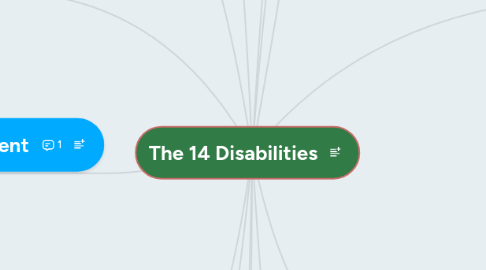
1. Deaf-Blindness
2. Deafness
3. Developmental Delay
4. Hearing Impairment
5. Intellectual Disability
6. Orthopedic Impairment
6.1. Neuromotor impairment is a defect in the nervous system, spinal cord or brain that sends impulses through the muscles of the body. It occurs at or before birth and can cause problems of limited limb movement, spine disalignment, no urinary control.
6.1.1. Cerebral palsy is a non progressive disorder from malfunctions or damages in the brain occurring at or within a few years of birth. They may result in spastic movements, athetoid movements, ataxic movements or any mix of these.
6.1.2. Spina bifida is caused by an opening in the spinal column that causes paralysis to parts of the body. It can sometimes affect intellectual functioning.
6.2. Degenerative diseases are those that affect motor development.
6.2.1. Muscular dystrophy is an inherited degenerative disease in which muscle weakness continues to progress as muscle fibers break down.
6.3. Musculoskeletal disorders impose physical limitations from the musculoskeletal system.
6.3.1. Juvenile rheumatoid arthritis
6.3.2. Limb deficiency
7. Other Health Impairment
8. Traumatic Brain Injury
9. Visual Impairment, Blindness
10. Autism
10.1. Regressive Autisitic Spectrum Disorder is a type of autism in which signs appear before two years of age as regression starts.
10.2. Pervasive Developmental Disorder is when a child shows some signs of autism but does not fit the standards of the other types of autism.
10.3. Asperger's Syndrome is a less severe form of autism which usually appears after two years of age. It primarily affects the child's social development.
10.4. Childhood Disintegrative Disorder is a rare type of autism that shows up before four years of age and shows a regression of language and motor skills.
10.5. Rett Syndrome is similar to Childhood Disintegrative Disorder except that it affects only girls.
11. Emotional Distrubance
11.1. Conduct disorder is marked by aggression, deceitfulness and a problem obeying rules or acting in socially acceptable manners.
11.2. Eating disorders involve eating habits that are averse to health.
11.2.1. Anorexia is a fear of weight gain from a distorted of self body size and shape.
11.2.2. Bulimia is marked by excess eating and then a purging activity carried to excess such as throwing up or excessive exercising.
11.3. Obsessive-compulsive disorder is a type of anxiety disorder marked by repetitive behaviors and/or recurrent throughts
11.4. Psychotic disorders cover those disorders that cause abnormal thinking and perception. They include the disorders that cause delusions and hallucinations.
11.4.1. Schizophrenia is marked by hallucinations and delusions, and though the cause is still under investigation, current evidence points to environment and genes. Symptoms typically don't appear until after sixteen years of age.
